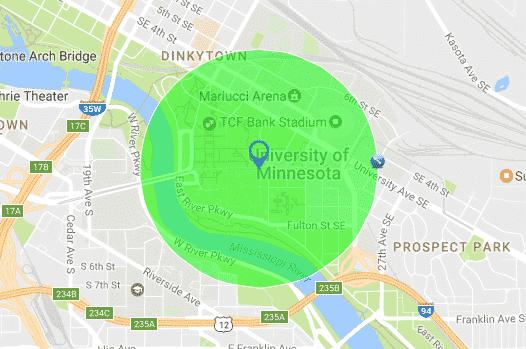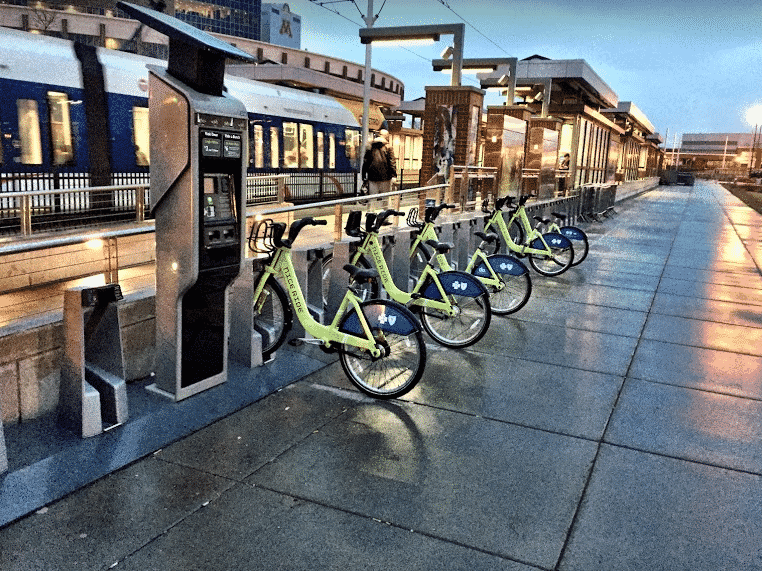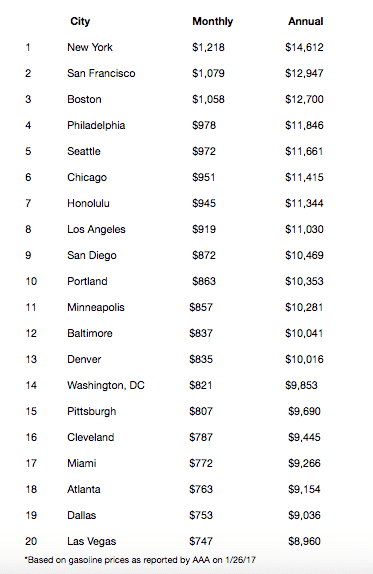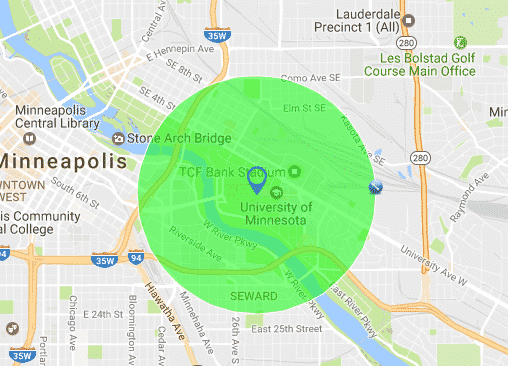One of the fun things about living in a college neighborhood is getting to see all of the different modes of transportation college kids use to get themselves around town. If you’ve never spent time in a college neighborhood as an adult, take a weekend afternoon and just hang out in one for a bit. I promise that you’ll never see so many creative ways to get yourself from Point A to Point B. Folks travel around on skateboards. Scooters. Rollerblades. Basically anything with wheels. These college kids are masters at figuring out how to get around a city quickly, cheaply, and efficiently.
Non-car based modes of transport that go beyond walking are totally normal in college areas but seem oddly out of place in many “adult” neighborhoods. I know that when I lived in neighborhoods populated primarily by young professionals, I saw far fewer people using bikes as a primary mode of transportation. In even fancier neighborhoods, you’ll probably rarely catch a full-fledged adult biking as a means of commuting.
An even more minuscule amount of people use what I’d deem to be “alternative” modes of transportation. These weird modes of transportation – things like skateboards, scooters, rollerblades, and other non-motorized wheel based forms of transport – are actually pretty common on a college campus. They’re not quite enough to be a sole form of transportation in themselves, but they do a great job of handling trips between 1 and 2 miles and connecting people to bigger forms of transportation.
These alternative modes of transportation essentially help to solve the Last Mile Problem. In the world of mass transit, the Last Mile Problem – sometimes referred to as the First Mile Problem – refers to the challenge of getting folks from their homes to a transportation hub and vice-versa. Think of things like train stations or major bus stops. Each of these transit hubs has a sort of zone of influence around them. Generally, that zone stretches out about 1/4 to 1/2 of a mile. Take a look at the below image:

That green circle is about the limit that a regular person will walk to get to a train station or bus stop. Any further, and most people will likely opt for a different mode of transportation – most likely their car. It’s faster to drive, of course. But it’s also expensive, worse for your health, and terrible for the world.
But college kids, by adopting these alternative modes of transportation, are showing us that the Last Mile Problem can be solved pretty easily and cheaply if we’re willing to think a little bit outside the box. By being willing to use alternative modes of transport to get to mass transit, that green circle can be extended quite a bit. I’d say by a mile at least. Take a look at how much more space that extra half mile can draw.
With major transit stops pretty much spread out throughout any city, almost everyone should be able to quickly commute to a transit hub. And the savings in solving this last mile problem are pretty big. According to one study, the average person saves $812 per month by making the switch to public transit for their daily commute.
The Last Mile Problem In Action
My own living situation is a great example of the Last Mile Problem. I have a bus stop just a block from my house, and that’s what I typically use to get to work in the winter or if it’s pouring rain. Buses, however, are bumpy and take a little bit longer. I much prefer the luxury of a train.
The only problem? My nearest train station is approximately 1.3 miles from my house. That’s about a 25-minute walk. Short enough that I could make the walk if I wanted to. But far enough away that I probably won’t do it.
And here is the problem of the last mile. This train station that can take me basically anywhere in the city for just 2 bucks (actually less for me because I have a subsidized pass giving me unlimited rides) is so close, yet so far. Faced with the decision of figuring out how to get to that train station or just driving to my destination, I’d probably just opt to drive.
But the amazing thing is that, by using a self-powered mode of transportation that contains a wheel, I can basically cut down my travel time by half or more. Instead of a 25-minute walk to that train station, wheeling my way over there might only take me 10 minutes. Suddenly, that far off transit hub isn’t so far away. And I get the added health benefits of using my own body to propel me to my destination.
Alternative Modes Of Last Mile Transportation
There are so many ways to bridge that last mile beyond just walking or using a traditional bike. At the outset, I’d like to note that, while a traditional bike is probably the most obvious form of last mile transit, I’ve always thought of it more as a primary mode of transportation akin to a car. You can bike miles and miles on a bike very quickly.
When I think about last mile transit, I’m thinking more in terms of methods of transportation that you can’t really sustain over long distances. These are basically methods of transportation that you’re using solely as a means to get yourself to another form of transit.
And, as much as I love biking, I’ve always preferred more compact modes of transport when I’m commuting. I’ve always hated having to bring my bike onto a train or bus. I much prefer being able to just walk onto it without having to think about anything.
With that out of the way, here are some alternative modes of transportation that I’ve been observing in my neighborhood that are helping to bridge that last mile:
Bike Share Systems
Without a doubt, bike share systems are my favorite mode of last mile transport. I’ve written before about what a terrific form of infrastructure these systems are for cities. Place a few bike share stations in strategic locations and suddenly, you’ve created an entire form of mass transit based solely around the bike. They also have the added benefit of normalizing biking. When biking seems normal, more people are apt to do it.
In addition, bike share systems are super cost effective. For a user like me who uses them at least twice per day, my cost per ride comes out to just 26 cents per ride. And that’s assuming I only used them to commute to and from work. My actual cost per ride is much lower considering that I use these bikes for pretty much any short distance trip I take.
You can see just how well bike share systems can bridge that last mile with my own situation. I have a bike share station just a block from my house. My closest train station has a bike share station right outside of it. By having these two bike share stations, that far off train station becomes an 8-minute bike ride away. And I never have to worry about fumbling with my bike on the way out the door, getting my bike onto a crowded train, or locking it up when I get to work.

If you live in a city, seriously consider signing up for a bike share system. I promise you it’ll change the way you move around the city.
Skateboards
I’ve always thought of skateboards as a recreational vehicle, but it turns out they’re actually terrific modes of transport to help bridge that last mile.
Take the example of my brother. A few weeks ago, he came to visit me for my bachelor party weekend. His flight landed around lunch, leaving him with an afternoon of waiting until I was done with work. Instead of sitting around at a coffee shop, he hopped on his skateboard, did some Postmates deliveries, and then skated on over to my house in the evening.
What makes the skateboard such a great last mile tool is its compactness. All you need to do is pick it up and carry it with you. My brother brought his skateboard with him on the plane. The downside with skateboarding is that you need to learn how to skateboard. I’ve tried to skateboard myself, but it’s not so easy for me and I don’t think I’d be comfortable doing it in a street. I did recently see some kid skateboarding using ski poles. Not quite sure if it was because he didn’t know how to skateboard or if it was faster, but an interesting move nonetheless.

We’re not in the Back to the Future world of hoverboards just yet, but the skateboard will do just fine to get you to where you need to go.
Scooters
There’s a surprising world of scooter commuters. When I talk about scooters, I’m referring to the kick scooters that you might see kids using. They look like this:
This is a surprisingly effective mode of transportation that’s about twice as fast as walking. I should know. Back when I graduated college, I moved back home and needed a way to get myself around town a little bit quicker. One day, I spotted an old Razor scooter I had sitting around in my house and thought I’d try using it in order to get to the subway a little bit faster.
Turns out those kick scooters are awesome if you can just ignore how goofy you might look. My nearest subway stop was about a 20-minute walk away. By using a kick scooter, I reduced that commute to a mere 10-minute scoot away.
Like a skateboard, scooters are super compact. All you need to do is fold it up and hold it. My scooter even had a strap, allowing me to sling it over my shoulder like a bag. It was basically no work to carry it onto a train.
And the nice thing about scootering is that it takes no skill. Anyone can pick it up immediately. Even learning how to ride a bike takes more time than figuring out how to use a scooter. If you’re thinking of scootering, you can grab a scooter on Craigslist for as little as $25. Those of you who are more hardcore will probably want to opt for an adult scooter with bigger wheels. I’ve personally used a kid’s scooter without any problems.
*For further reading, check out this post on scooter commuting in the DC area. Interesting stuff.
Rollerblading
I’ve seen a bunch of college kids rollerblading to class as well. When you think about it, rollerblading is a terrific way to bridge that last mile. You’re effectively putting wheels on your feet. When you get to your destination, all you need to do is take those rollerblades off and go back to regular shoes. Seems like an interesting form of transportation if you know how to rollerblade.
How Much Is That Last Mile Worth?
Think outside the box and you can open up the entire world of mass transit to you. If you’re fortunate enough to live in a city with good mass transit, any transit station within a mile or two of you can now become accessible if you’re willing to use multi-modal transit options to bridge that last mile.
Since this is a personal finance blog, what we probably care about is how much that last mile is worth. Here’s a chart from the American Public Transportation Association showing the average monthly and annual savings of using mass transit to get to work instead of a car.

Recent estimates suggest that a person can save an average of $9,738 per year by opting for mass transit over a car. What this means is that, if you’re not using mass transit because you think it’s too far away from you, you’re leaving thousands of dollars per year on the table.
How much are you missing out on? $9,738 per year over a decade comes out to $97,380. And that’s assuming we don’t invest that surplus. If we invest it, that $9,738 can turn into about $143,962 over a decade. That’s good enough to generate $5,758 per year for the rest of your life! All that just from spending $75 or so per year on a bike share system. Or dropping $25 on a scooter from Craigslist. And don’t forget the health benefits and other external societal benefits that come along with not using your car.





Overcoming the challenges of last mile deliveries is a need of the hour to fulfill the drastically increasing demand of the consumers. For this, last mile delivery software can help us overcome some of the biggest obstacles faced by the courier industry today. Thanks for sharing the above information.
Access to mass transit was one of the most important criteria for me a couple of years back, when I decided to relocate from inside the city centre to a suburb. Because the location was picked with this in mind, we’re as well connected to the city as a large part of the populace living within the city limits, being a five minute walk and a 15 minute train ride away from the city central station.
And we live in a house which, at best, would cost twice what we paid for it. So I’m a huge fan of public transit, as a way of “geo-arbitraging” yourself to better living conditions in decent locations. Within the local community, everything is within walking distance as well, which has made our car all but redundant. And that has resulted in significant savings, as opposed to relying on the car for transportation every day.
That is awesome to hear! And great job picking access to mass transit when figuring out where to live. I always do the same thing, more out of necessity, simply because I don’t have my own car and rarely drive.
Fortunately in Sydney the public transit is very well developed here. The trains come every few minutes and they’re really clean (unlike the subway in some north a,era am cities).
I’ve never been to Sydney but I’ve heard great things. It’s always a huge benefit when you’ve got access to really good transit like that. Do you find that more people use it then or is there still a sort of stigma with using mass transit? Here in the states, in some cities, people act as if using mass transit isn’t possible because it’s dangerous or something (which to me sounds ridiculous). I have a buddy in Atlanta for example who swears he can’t take the buses or trains there because of danger. I’m always like, really? because that sounds like an excuse to me.
While mass transit may no longer be “dangerous” in the sense that you risk life and/ or limb, as it was in NYC in the late 70s/ early 80s, some cities still have a ways to go before folks with alternatives elect to take public transportation over a private car. Atlanta is an example. Their elevated train is called the MARTA (Metropolitan Atlanta Rapid Transit Authority), but look up what Atlantans say it stands for and Google some reviews…
Last year I spent $2700 on various auto costs (insurance, gas, oil changes, etc). I would LOVE to be able to take the train, but my area doesn’t have anything like that. Just a bus. And that bus would take me almost 90 minutes to get to work when driving takes me 20. Add in my variable schedule and driving is the only option.
Hopefully, though, the train to Chicago will be done next year and I can take the train to the city instead of driving myself!
Admittedly not every city has great transportation. Your options will unfortunately be limited if you’re living far from a city center.
It’s one of the things I look at when trying to figure out where to live just because I’ve never owned my own car and hate driving. That’d be sweet if that train gets finished!
The people who have cars where I live either have families or second homes in upstate NY. And then you spend half the week driving around to find a new parking spot because of street cleaning days.
As someone who doesn’t have a car, I’m always curious to know how much people are spending on gas, insurance, etc., so see how it compares to a subway pass. For me, it costs $121 per month for a pass, which you can use for the trains AND the bus. I almost never take cabs or anything, unless it’s late and I’m in a sketchy neighborhood. I count my lucky stars the ticket price isn’t distance-based, too. You can literally go from one corner of the city to the other end for $2.75!
As for your alternative options, I like the scooter one best because it’s the most portable. I see guys in suits here doing it, and don’t think it’s weird at all. For the bike share, how long do you have the bike for before you have to dock it? I tested one out here, and I felt like I was in a stressful video game because you only have 30 minutes to dock the bikes at another station.
The scooter option is great because right, you can do it in a suit! That’s exactly what I used to do and it didn’t seem bad at all. Just make sure you’re not wearing your fanciest shoes while you do it.
Here in the Twin Cities, annual subscribers get 1 hour before we need to dock it again. I’ve never had a problem since an hour of biking is a pretty long time! 30 minutes is a little bit shorter, but I feel like most people can get to another dock within 30 minutes.
This morning I was running a search on Google maps for something I didn’t know the exact location not far from work. The results of that Google search proved that carless is not an option. I’m five minutes by car from work. But as a rural resident I’m over an hour by public transit to the same place. Biking would be possible if it was safe, but it’s not (no shoulder blind corner rural roads). If I lived in a less remote area I’d be all over public transit.
Admittedly, this post was geared more towards city dwellers. If you’re in a rural area, it’ll be harder since transit requires density.
Lol. “The Warriors” would have been a very different movie if set in the country…
This is even a problem in the city… I live in a city but not in the centre. Bike sharing or e-scooters are far and few between… My area is dense. Im 5 mins by foot from a major shopping street. But I guess its just not attractive enough for companies who offer first/last mile solutions, at least not compared to the centre. Strange stuff!
All excellent points FP, unfortunately my neck of the woods is a public transit nightmare. I’ve seen good public transit systems, I love good public transit systems, but Southern California is a ——— nightmare if you don’t have a car. Electric bicycle yes, car yes, but avoid the buses. Also the subway.
The train system is worthwhile, but it is so Under built its more like a Last Marathon Problem.
I’m not against public transport, but you have to treat it right. Hong Kong and Tokyo are amazing, Southern California’s is trash and smells like it. ????
Yeah, I hear a ton from friends living in California that using mass transit there isn’t possible. To be honest, I have no idea if it’s true or not since I’ve only been to So-Cal once. If it’s true, that’s a public policy problem there that should be addressed. Only way to do that I’d imagine is if is more people are willing to step up and demand better transit options.
Yeah, Houston is like metro LA in so many ways, including public transportation. I live only about 5.5 miles from my office. It’s 16 minutes by car, 33 minutes by bike, and an hour and 15 minutes by bus. Even though going by bike would double my commute time, I’d still consider it on nice days when I wasn’t in a hurry – if biking on the roads between my house and office during rush hour (or any time of the day, really) weren’t borderline suicidal.
I have a Razor A5 Lux I enjoy riding around my neighborhood and on the hike and bike trail through the greenway along Buffalo Bayou behind my neighborhood with my daughter, and I’m always looking for places in Houston where I could ride it to a real “destination”, but few and far between in Houston, and most of the time I’d have to drive somewhere to get to where I could use it – kinda defeats the point.
And note to Financial Panther, the two map graphics showing the radius people will travel from a rail station in the University of Minnesota, I think they would have been more impactful if you hadn’t changed the scale between the two. The size of the radius looks to the eye about the same in both pictures. If you had used the second map’s scale for both pictures, the radius would have immediately appeared significantly larger.
I live in Denver, where I commute 11 miles to work (each way). I’ve also lived in Chicago and DC (about 10 years combined), where I didn’t have a car and commuted by bus/ rail. Based on my experience the numbers just don’t sound accurate. Could it possibly be that the American Public Transportation Association-funded study’s methodology is just a little biased toward non-car transportation?
I’m sure there’s a bias towards it considering the mission of a non-profit group dedicated to improving mass transit.
At the same time though, I don’t think those costs are all that far off. AAA states that the annual cost to operate a vehicle is around $8,698, which doesn’t seem that far off from the amounts listed here assuming you’re dropping a car and going for mass transit instead.
If it helps, here’s the methodology used by the APTA:
And if it helps, Mr. Money Mustache himself estimated the savings in biking to work over a decade at $93,000. He did include the monetary benefits in increased health, but still, numbers aren’t all that far off from what APTA has listed here, especially if we were to just include improved health into our numbers.